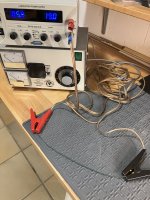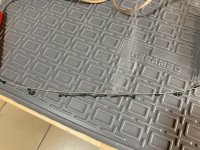Mr Mark
Squeezebaggeroni...
My main instrument of choice is an older Hohner Tango IIB. I prefer the 80 bass simple 3/4 reed configuration (removed the piccolo in the bass) as I stand to play and am definitely a stroller where the instrument compliments my vocals as much as anything. I have rebuilt most components on the instrument and finely tuned things to where I am truly satisfied with the sound.
Except for the loudness of the keyboard. The main issue is the pressing of the keys, not the release, so I would like to add some felt under the keys. The problem is that the axle is really stuck. I have tried silicone spray between the keys soaking in (not too much, I'm afraid of swelling the wood!) and have gone so far as to buy one of those keyboard axle removal tools but the thing wont budge. I am only willing to twist so far because of course I do not want to shear the axle right off! I have to say, I have several accordions of this vintage (85+ years) and they all have the same issue, so it would be nice to have a solution for all.
It seems the only solution left is the electricity trick. I have done this before with moderate success, but found that the car battery method isn't ideal as the results are instantaneous - for better and for worse. While the rod came loose, it permanently stayed that way as the holes all got a tiny bit bigger resulting in a less than desirable amount of keyboard 'slop' (side to side rocking). This in turn meant the pallet had way too much movement and wouldn't settle back in the same place twice (causing leaks, notes to sound, and pallets flat out landing on top of each other). While I did find a solution of sorts (without reboring a larger sized rod as I do not have the capabilities) in paper hole reinforcements, this also proved to be less than ideal as with time they wear out or gum up.
So my thoughts are along the lines of a much more controllable electrical charge. The problem is I have no idea how I would accomplish this as I am not an electrician. It seems to me that a car battery is way overkill. Is there somehow a smaller sized battery that would be more appropriate? Something with a way to turn the juice up and or down? Something that doesn't require a tow truck once the jumper leads have fused to the axle rod and fried my car battery? Am I overthinking this (I already know yes and no )?
)?
Thanks for indulging me.
Except for the loudness of the keyboard. The main issue is the pressing of the keys, not the release, so I would like to add some felt under the keys. The problem is that the axle is really stuck. I have tried silicone spray between the keys soaking in (not too much, I'm afraid of swelling the wood!) and have gone so far as to buy one of those keyboard axle removal tools but the thing wont budge. I am only willing to twist so far because of course I do not want to shear the axle right off! I have to say, I have several accordions of this vintage (85+ years) and they all have the same issue, so it would be nice to have a solution for all.
It seems the only solution left is the electricity trick. I have done this before with moderate success, but found that the car battery method isn't ideal as the results are instantaneous - for better and for worse. While the rod came loose, it permanently stayed that way as the holes all got a tiny bit bigger resulting in a less than desirable amount of keyboard 'slop' (side to side rocking). This in turn meant the pallet had way too much movement and wouldn't settle back in the same place twice (causing leaks, notes to sound, and pallets flat out landing on top of each other). While I did find a solution of sorts (without reboring a larger sized rod as I do not have the capabilities) in paper hole reinforcements, this also proved to be less than ideal as with time they wear out or gum up.
So my thoughts are along the lines of a much more controllable electrical charge. The problem is I have no idea how I would accomplish this as I am not an electrician. It seems to me that a car battery is way overkill. Is there somehow a smaller sized battery that would be more appropriate? Something with a way to turn the juice up and or down? Something that doesn't require a tow truck once the jumper leads have fused to the axle rod and fried my car battery? Am I overthinking this (I already know yes and no
Thanks for indulging me.


